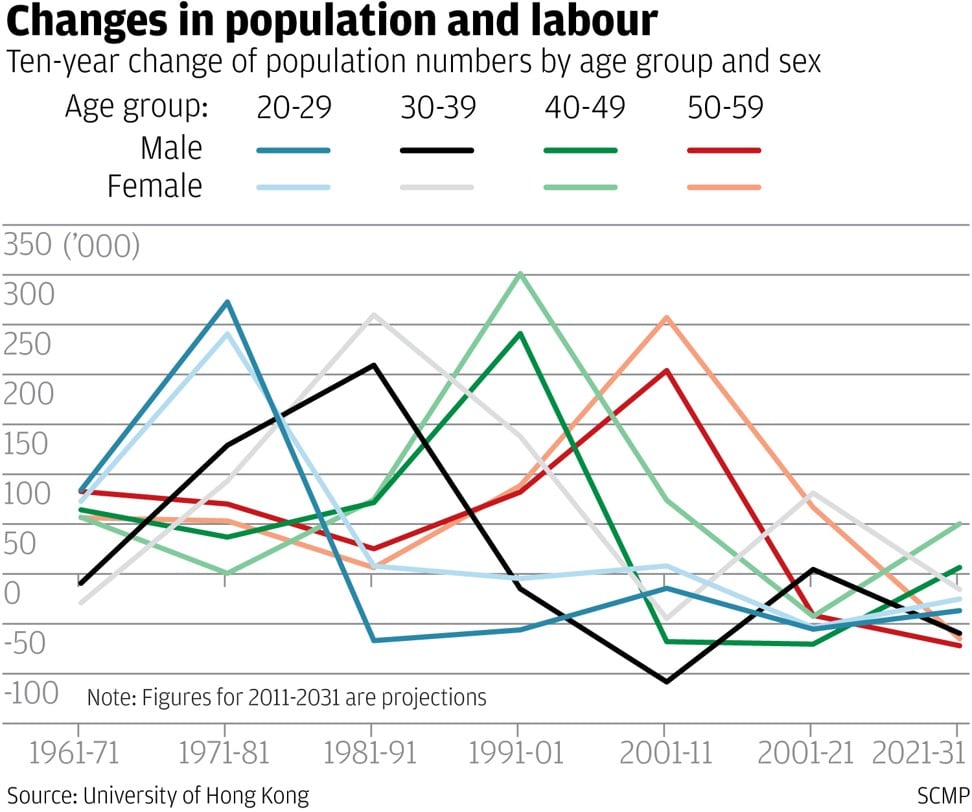
Blame 25-44 year olds for slowing of Hong Kong’s GDP since handover
Hong Kong hit with slower economic growth and increased economic inequality since 1997 compared to the previous twenty years
In the twenty years since the establishment of the Special Administrative Region, Hong Kong has experienced slower economic growth and increased economic inequality compared to the previous twenty years. Why is that?
Average annual GDP and GDP per capita increased, respectively, by 6.6 and 4.8 per cent in the period 1977-1997, but 3.2 and 2.6 per cent in 1997-2017.
Among households with heads aged 20-65 years old, the Gini-coefficients on the distribution of household income (before government transfer subsidies) increased from 0.432 in 1976, to 0.477 in 1996 and 0.507 in 2016 – a higher figure means greater inequality.
The changes in growth and inequality are fairly large between the two periods. Why have these figures worsened by so much? And how should we judge this economic performance?
I have come across several popular explanations for our relatively poor economic performance since 1997.
These include the detrimental effects of the Asian Financial Crisis and the Global Financial Tsunami, Hong Kong’s continued adherence to ‘positive non-interventionism’ (although I would argue there is greater intervention now given the hurdles that make it difficult for Uber, Airbnb, medical doctors and all sorts of businesses and skilled workers to operate in Hong Kong), the rapid structural transformation of Hong Kong’s economy from export-oriented manufacturing to more regulated services following China’s opening in 1979, and the ever-present problem of rising rents and property prices.
Hong Kong’s historic lead over Singapore in total factor productivity (which measures the productivity of an economy) has fallen sharply, from being 7.7 per cent higher in the 1970s ....and in the period 2010-14 Hong Kong actually fell behind Singapore by 5.7 per cent
Some of these factors are not without merit, but it is not always easy to demonstrate empirically if their cumulative effects can account for Hong Kong’s poor economic performance.
Every industry, no matter how large, is still a small part of the overall economy so the negative impact is often greatly exaggerated.
If a primary cause for Hong Kong’s economic slowdown and increasing inequality could be found, it is likely to be the changes in population and labour.
Employment accounts for a half to two thirds of GDP in most rich economies and Gini-coefficients in most countries measure only labour incomes.
In this instance, Hong Kong’s poor economic performance in the past 20 years could be said to have its origins in the population structure it inherited from the immediate post-war years, which created waves of population surge and collapse by age cohorts.
The number of children born in the 1950s was by far the highest among all post-war cohorts; but fewer were born in the 1970s and fewer still in the 2000s.
The impacts of these groups have cascaded down the years, although with an anomaly created by cross-border marriages that minimised the reductions in females aged 20-29 from 1981 to 2011 compared with males.
The changes brought about by the different age cohorts have greatly affected the size and composition of the employed workforce.
Although the average years of schooling in the population has improved as a result of the expansion of education, this has not increased enough to improve productivity and make up for the decline in numbers of those aged 25-44.
From 1971 to 1996, the aggregate years of schooling among employed men and women aged 25-44 years old grew rapidly, but the growth slowed especially among employed men.
This situation explains Hong Kong’s slow growth and also its declining economic performance in comparison to Singapore, which has aggressively sought to increase the size and education quality of its workforce.
Hong Kong’s historic lead over Singapore in total factor productivity (which measures the productivity of an economy) has fallen sharply, from being 7.7 per cent higher in the 1970s, 13.8 per cent higher in the 1980s, and 46.8 per cent higher in the 1990s, to only 5.9 per cent higher in the 2000s. Even worse, in the period 2010-14 Hong Kong actually fell behind Singapore by 5.7 per cent.
The 25-44 year olds are usually the most innovative segment of the entire workforce. Their slow growth in terms of both numbers and human capital endowment [the skills and capacities that reside in people and that are put to productive use] is in my view the single most important factor that has slowed down Hong Kong’s GDP and GDP per capita growth since 1997.
The increase of economic inequality is in part a result of the failure of our population and education policies. This does not rule out the relevance of other factors, but if it is not remedied, it will be difficult to make any significant improvements.
Hong Kong’s economic future depends on it, assuming of course that ‘one-country two-systems’ will be in place.
Richard Wong is the Philip Wong Kennedy Wong Professor in Political Economy at the University of Hong Kong


